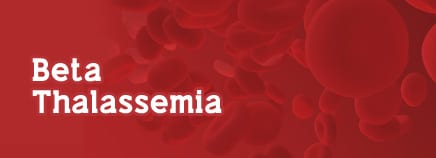What is Beta Thalassemia Trait?
Beta thalassemia trait, also called beta thalassemia minor, occurs when an individual inherits a normal geneform one parent and the beta thalassemia gene from the other parent. The red blood cells are smaller than usual, which sometimes causes misdiagnosis with an iron deficiency. Beta thalassemia trait needs no treatment. Individuals with this condition can pass the beta thalassemia gene to their children.
What is Sickle Cell Beta Thalassemia Disease?
Sickle cell beta thalassemia disease occurs when a person inherits a gene for sickle hemoglobin from one parent and a beta thalassemia gene from the other parent. There are two types of Sickle cell beta thalassemia disease, 0 and +.
The sickle hemoglobin causes the red blood cells to change from a very flexible, round shape into a rigid, crescent moon or sickle shape. Sickle shaped red blood cells prevent the normal flow of blood and oxygen to body organs.
What are the Signs and Symptoms?
Symptoms of sickle cell beta 0 thalassemia disease include painful episodes, tiredness, an enlarged spleen and higher risk for infections. Individuals with sickle cell beta thalassemia have a milder form of the disease. Sickle cell beta thalassemia symptoms vary from person to persona.
People affected should drink plenty of water and avoid climate extremes and activities that cause inflammation and extreme fatigue. It is important that they stay up to date on all immunizations. Sickle cell beta thalassemia is associated with a variety of health problems, which need close follow-up by a health provider.
What is the Treatment?
Medical care includes regular physical examinations, specialized laboratory tests, and imaging studies such as chest X-ray, transcranial doppler ultrasound, and an electrocardiogram (ECG). Health care providers may prescribe blood transfusions regularly for those with a history of risk factors for stroke and other health problems.
The drug hydroxyurea can decrease the frequency and severity of pain episodes; reduce the need for blood transfusions; and increase life span. The U.S. Food and Drug Administration first approved hydroxyurea for treatment of sickle cell disease in 1998.
What do I do now?
Get yourself and your family tested to see if you are a carrier for an abnormal hemoglobin. If you take the test, ask your provider to perform a hemoglobin electrophoresis for accurate results. See your provider or call the Foundation for genetic counseling about your test results. This provides you with the facts to make an informed decision about having children children.
What is Hemoglobin?
Hemoglobin is the part of the blood that carries oxygen from the lungs to all parts of the body. There are different types of hemoglobin. Your hemoglobin type comes from the genes you inherit from your parents. Genes are instructions in each of our cells that determine a person’s traits such as eye color, blood type and risk of disease. Hemoglobin A is the most common type and is normal.
When there is not enough hemoglobin, the body’s red blood cells do not function properly and they last for a shorter period of time. As this happens, there are fewer healthy red blood cells circulating in the blood stream to take oxygen to all the cells of the body. This may cause a person to experience shortness of breath or to feel tired or week. This condition is called anemia.
What is Thalassemia?
Thalassemia is an inherited blood disorder caused when the body doesn’t make enough hemoglobin. People with Thalassemia may have mild or severe anemia. This condition is treatable and is managed well with blood transfusions and chelation therapy. People with thalassemia may do better if they learn how to stay healthy and stay up-to-date on immunizations.
Thalassemia is commonly found in people for Mediterranean countries, like Greece and Turkey; and in people from Asia, Africa and the Middle East. If you have anemia and you have family members from these areas, your health provider can test your blood to find out if you have thalassemia.
What is Beta Thalassemia Disease?
Often called Cooley’s anemia, this is a very severe type of anemia caused by an individual inheriting a beta thalassemia gene from each parent, this combination causes a decreased production of hemoglobin. An individual with beta thalassemia disease produces red blood cells at a rapid rate, but the cells are destroyed quickly and are unable to transport needed oxygen throughtout the body.
What are the signs and symptoms?
Some of the more common sympotoms of beta thalassemia may include anemia (low levels of red blood cells); repeated infections; frequent episodes of pain; pulmonary hypertension; and acute chest syndrome, a pneumonia-like condition caused by the entrapment of infection or sickle cells in the lungs.
What is the Treatment?
Beta thalassemia disease is a life-threatening disease. It is treated at regular intervals with blood transfusions. Most children require transfusions about every four weeks. Repeated transfusion, however, can cause complications, such as difficulty finding a blood match and iron overload.
At this time, the primary treatments focus on relieving symptoms. Selected patients may quality for bone marrow or steam cell transplants. Gene theraphy is considered a potential treatment.
Written by Leslie Fontenot
Sickle Cell Foundation of Georgia
Beta Thalassemia






